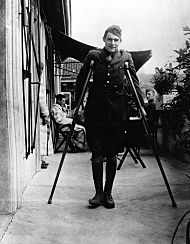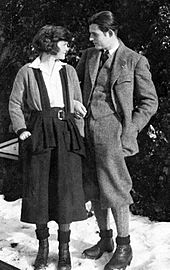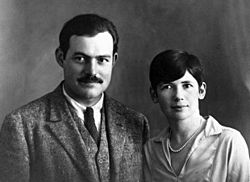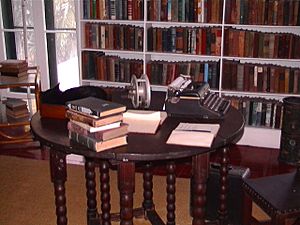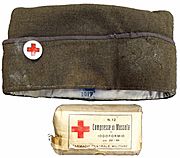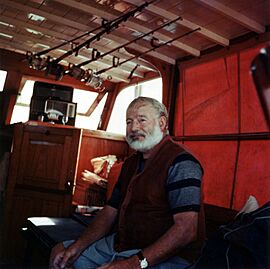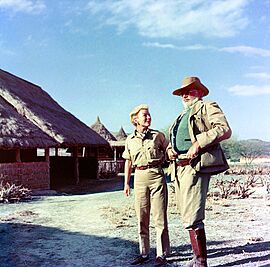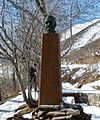Ernest Hemingway facts for kids
Quick facts for kids
Ernest Hemingway
|
|
|---|---|
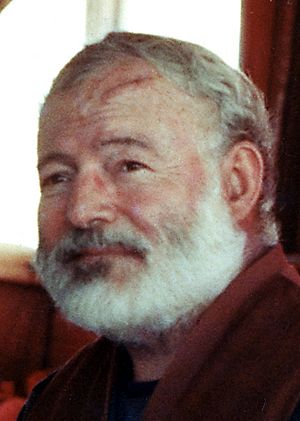
Hemingway in 1950
|
|
| Born | July 21, 1899 Oak Park, Illinois, United States |
| Died | July 2, 1961 (aged 61) Ketchum, Idaho, United States |
| Nationality | American |
| Notable awards | Pulitzer Prize for Fiction (1953) Nobel Prize in Literature (1954) |
| Signature | |
Ernest Miller Hemingway (born July 21, 1899 – died July 2, 1961) was a famous American writer. He won the 1954 Nobel Prize in Literature for his amazing stories.
Hemingway grew up in Oak Park, Illinois, a town near Chicago. After high school, he worked as a reporter for a newspaper. He then joined the Red Cross during World War I. He drove an ambulance on the Italian Front and was badly hurt in 1918.
In 1921, Hemingway moved to Paris, France. He worked as a reporter there. His first important novel, The Sun Also Rises, came out in 1926. He returned to the U.S. in 1928 and lived in Key West, Florida. His war experiences helped him write his 1929 novel A Farewell to Arms.
In 1937, Hemingway went to Spain to report on the Spanish Civil War. This war inspired his 1940 novel For Whom the Bell Tolls, which he wrote in Havana, Cuba. During World War II, he was a journalist with Allied soldiers. He was there for the Normandy landings and the liberation of Paris. In 1952, his novel The Old Man and the Sea was published. It was highly praised and won the Pulitzer Prize for Fiction. In 1954, he was hurt in two plane crashes in Africa. This left him in pain for much of his later life.
Contents
- Ernest Hemingway's Early Life
- Starting as a News Reporter
- Hemingway's Time in Europe
- Life in Chicago
- Living in Paris
- First Success in 1925
- The Sun Also Rises
- Marriage to Pauline Pfeiffer
- A Farewell to Arms
- Death in the Afternoon
- The Snows of Kilimanjaro
- For Whom the Bell Tolls
- Life in Cuba and the Nobel Prize
- Death
- Interesting Facts About Ernest Hemingway
- Ernest Hemingway Quotes
- Hemingway's Influence and Legacy
- Hemingway's Writing Style
- Themes in Hemingway's Works
- Selected Works
- Images for kids
- See also
Ernest Hemingway's Early Life
Ernest Miller Hemingway was born on July 21, 1899. His hometown was Oak Park, Illinois. His father, Clarence Edmonds Hemingway, was a physician. His mother, Grace Hall Hemingway, was a musician. They were well-educated and respected in their community. Ernest was the second of six children in his family.
Every summer, his family went to their holiday home in northern Michigan. Ernest's father taught him many outdoor skills. He learned how to catch fish, hunt, set up a camp, and cook over a fire.
Hemingway attended Oak Park and River Forest High School. He was there from 1913 to 1917. He played sports like boxing, track and field, water polo, and football. He also played in the school orchestra for two years. Ernest got good grades in his English classes. In his last two years, he edited the school newspaper and yearbook. He tried to write like the famous sports writer, Ring Lardner.
Starting as a News Reporter
In 1917, Hemingway decided not to go to college. The United States had just joined World War I. He wanted to join the Army, but they said no. His eyesight was not good enough for military service.
Ernest found a job at The Kansas City Star newspaper. This was in Kansas City, Missouri. He only worked there for six months. But the newspaper's style guide greatly influenced him. It said: "Use short sentences. Use short first paragraphs. Use vigorous English. Be positive, not negative." This became a key part of his writing style.
Hemingway's Time in Europe
Hemingway worked for the newspaper for nine months. Then he joined the Red Cross. He wanted to help on the battlefields in Europe. His job was to drive an ambulance. He would take wounded soldiers away from the fighting.
The Red Cross sent him to Italy. On his first day in Milan, he went to a factory explosion site. He helped rescuers there. A few days later, he was stationed at Fossalta di Piave.
On July 8, 1918, his group came under mortar fire. This happened right after he brought chocolate and cigarettes to the men. Hemingway was seriously wounded. Even with his injuries, he helped Italian soldiers get to safety. For this, he received the Italian War Merit Cross, called the Croce al Merito di Guerra. He was only 18 years old. Hemingway later said that when you are young, you think you cannot be hurt in war. But after being badly wounded, you realize it can happen to you. He had severe shrapnel wounds in both legs. He had surgery and spent five days in a field hospital. Then he spent six months recovering at a Red Cross hospital in Milan.
When the war ended in 1919, Hemingway returned to the United States. It was hard for him to adjust to life back home. A family friend offered him a job in Toronto, Canada. Ernest accepted because he had nothing else to do. Later that year, he started writing for the Toronto Star Weekly. He moved back to Michigan in June and then to Chicago in September 1920.
Life in Chicago
In Chicago, Hemingway worked as an editor for a magazine called Cooperative Commonwealth. There, he met the novelist Sherwood Anderson. Anderson was one of the first American writers to write about everyday people. Hemingway saw that Anderson's stories showed life as it truly was. This was similar to what he wanted to achieve in his own writing.
Anderson gave Hemingway advice about his writing. He told Hemingway to move to Paris, France. Life was cheaper there. Anderson also said that Paris had many young artists and writers. These creative people came from many different nations.
Living in Paris
Hemingway decided to move to Paris. Before he left America, he married a woman named Hadley Richardson. They had recently met.
Paris was cold and grey when Hemingway and Hadley arrived in 1921. They lived in a poorer part of the city. Their rooms were small and did not have running water. But the Toronto Star hired him as their European reporter. This job gave them enough money to live. It also gave Hemingway time to work on his own stories.
Hemingway loved exploring Paris. He learned French customs and met new friends. Many of these friends were artists and writers who came to Paris in the 1920s. Among them were the poet Ezra Pound, and writers Gertrude Stein, John Dos Passos, and F. Scott Fitzgerald. They saw that Hemingway was a good writer. They helped him publish his stories in the United States.
Hemingway traveled all over Europe. He wrote about politics, peace conferences, and border disputes. He also wrote about sports, skiing, and fishing. Later, he would write about bullfighting in Spain. The Toronto Star liked his work and wanted more reports. But Hemingway was busy with his own writing.
He once said: "Sometimes, I would start a new story and could not get it going. Then I would stand and look out over the roofs of Paris and think. I would say to myself: 'All you have to do is write one true sentence. Write the truest sentence you know.' So finally, I would write a true sentence and go on from there. It was a wonderful feeling when I had worked well."
During his first 20 months in Paris, Hemingway sent 88 stories to the Toronto Star. Sadly, almost all his early fiction and short stories were lost. This happened in December 1922. His wife, Hadley, was traveling to meet him in Geneva. She lost a suitcase full of his writings at the Gare de Lyon train station. Hemingway was very upset. Nine months later, the couple returned to Toronto. Their son John Hadley Nicanor was born there on October 10, 1923. While they were away, Hemingway's first book, Three Stories and Ten Poems, was published in Paris.
First Success in 1925
Hemingway, Hadley, and their son (nicknamed Bumby) returned to Paris in January 1924. They moved into an apartment on the rue Notre-Dame des Champs. Hemingway's first collection of stories, In Our Time, was published in 1925.
One of its stories was "Big Two Hearted River." It told about how war affected a young man. He was on a long fishing trip in Michigan. Hemingway had learned about living in the wild from his father when he was a boy.
The story describes two kinds of rivers. One is calm and clear, where the young man fishes. The other is a dark, scary swamp. The story shows the main character trying to forget his past and the war. He does not talk much about the war. The reader learns about him not because Hemingway tells us what he thinks. Instead, he shows the man learning about himself. Many people think it is one of the best modern American stories ever. Because of this, "Big Two Hearted River" is often included in collections of great writing.
The Sun Also Rises
Hemingway was working on a long story. He wanted to publish a novel. He knew this would make him known as a serious writer. He also wanted the money a novel would earn.
The novel was called The Sun Also Rises. It is about young Americans living in Europe after World War One. The war had ruined their dreams. It had left them feeling lost. The writer Gertrude Stein later called these people members of "The Lost Generation."
The book was an instant success. At the age of 25, Ernest Hemingway became famous.
Marriage to Pauline Pfeiffer
With his novel's success, Hemingway became even more popular in Paris. Many people came to meet him. One was an American woman named Pauline Pfeiffer. She became Hadley's friend. Then Pauline fell in love with Hemingway.
Hemingway and Pauline saw each other secretly. One time, they went on a short trip together. Years later, Hemingway wrote about coming home after that trip:
"When I saw Hadley again, I wished I had died before I ever loved anyone but her. She was smiling and the sun was on her lovely face."
But his first marriage ended. Ernest Hemingway and Hadley separated. She kept their son. He agreed to give her money he earned from his books.
In later years, he looked back at his marriage to Hadley. He remembered it as the happiest time of his life.
At twenty-five, Hemingway was living in Paris. He was a famous writer. But the end of his first marriage made him want to leave the place where he had become famous.
Much later he said, "the city was never to be the same again. When I returned to it, I found it had changed as I had changed. Paris was never the same as when I was poor and very happy."
Hemingway and his new wife, Pauline, returned to the United States in 1928. Their son Patrick was born on June 28, 1928.
Soon after, Hemingway heard that his father had died. This news deeply affected Hemingway. He said, "My father taught me so much. He was the only one I really cared about."
The family settled in Key West, Florida. They lived there from 1931 to 1939. Before leaving Paris, Hemingway sent a collection of his stories to New York to be published. The book, called Men Without Women, came out in October 1927.
Hemingway's third child, Gloria Hemingway, was born on November 12, 1931.
In 1934, Hemingway bought a boat. He named it the Pilar. He began to sail around the Caribbean.
A Farewell to Arms
His new book told the story of an American soldier. This soldier served with the Italian army during World War One. He meets an English nurse, and they fall in love. They run away from the army. But she dies during childbirth. Some of the events in the book are based on Hemingway's own time serving in Italy. The book is called A Farewell to Arms.
Part of the book describes the defeat of the Italian army. This happened at a place called Caporetto:
"At noon we were stuck in a muddy road about as nearly as we could figure, ten kilometres from Udine. The rain had stopped during the forenoon and three times we had heard planes coming, seen them pass overhead, watched them go far to the left and heard them bombing on the main highroad. . . .
Later we were on a road that led to a river. There was a long line of abandoned trucks and carts on a road leading up to a bridge. No one was in sight. The river was high and the bridge had been blown up in the center; the stone arch was fallen into the river and the brown water was going over it. We went up the bank looking for a place to cross. . . . we did not see any troops; only abandoned trucks and stores. Along the river bank was nothing and no one but the wet brush and muddy ground."
Death in the Afternoon
A Farewell to Arms was very successful. It earned Hemingway a lot of money. This allowed him to travel.
One place he visited was Spain, a country he loved. He said, "I want to paint with words all the sights and sounds and smells of Spain. And if I can write any of it down truly, then it will represent all of Spain."
He wrote a book called Death in the Afternoon. It describes the Spanish custom of bull fighting. Hemingway believed that bullfighting was an art form. He felt it was just as much an art as writing was. He also believed it was a true test of a man's bravery.
The Snows of Kilimanjaro
Hemingway also traveled to Africa. He was asked to write a series of reports about hunting in Africa. He said, "Hunting in Africa is the kind of hunting I like. No riding in cars, just simple walking and feeling the grass under my feet."
His trip to Africa led to a book called The Green Hills of Africa. It also resulted in many shorter stories.
One story is considered one of Hemingway's best. It is called The Snows of Kilimanjaro. The story talks about Hemingway's own fears. It is about a writer who gives up his art for money. This writer cannot stay true to himself.
For Whom the Bell Tolls
In 1936, the Civil War in Spain began. This gave Hemingway a chance to return to Spain. He wanted to test his bravery again. He signed with North American Newspaper Alliance to cover the Spanish Civil War. He sailed from New York on February 27, 1937. Journalist and writer Martha Gellhorn went with Hemingway.
His trip to Spain resulted in two works. One was a play called The Fifth Column. The other was a novel called For Whom the Bell Tolls. The novel tells the story of an American man. He chooses to fight against the fascists. He realizes there are lies and injustice on his own side. But he sees no hope unless his side wins. During the fighting, he overcomes his fear of death and being alone. He decides that "he can live as full a life in seventy hours as in seventy years."
Life in Cuba and the Nobel Prize
For Whom the Bell Tolls was a great success. Hemingway enjoyed being famous. His second marriage was ending. He divorced Pauline and married Martha Gellhorn. The couple decided to live in Cuba, near the city of Havana. Their house looked out over the Caribbean Sea.
But this marriage did not last long. They often argued. Martha left for Europe in September 1943 to report for Collier's.
When America entered World War Two, Hemingway went to Britain as a reporter. Later, he took part in the invasion of Europe. He was also there for the freeing of Paris. During the war, Hemingway met another reporter, Mary Walsh. In 1945, after his marriage to Martha ended, he married Mary.
The Hemingway family had several accidents and health problems after the war. In a 1945 car accident, he hurt his knee and head again. A few years later, Mary broke her right ankle, then her left, in skiing accidents.
Hemingway became sad as his writer friends started to die. During this time, he had bad headaches, high blood pressure, weight problems, and later, diabetes. Still, in January 1946, he started writing The Garden of Eden. He finished 800 pages by June.
In 1948, Hemingway and Mary traveled to Europe. They stayed in Venice for several months. While there, Hemingway met 19-year-old Adriana Ivancich. This friendship inspired the novel Across the River and into the Trees. He wrote it in Cuba during a difficult time with Mary. It was published in 1950 but received bad reviews. The next year, angry about the reviews, Hemingway wrote The Old Man and the Sea in eight weeks. He said it was "the best I can write ever for all of my life." Published in September 1953, The Old Man and the Sea became very popular. It made Hemingway famous worldwide and won the Pulitzer Prize in May 1953. A month later, he left Cuba for his second trip to Africa.
While in Africa, Hemingway was seriously hurt in two plane crashes in January 1954. He had rented a plane to see the Belgian Congo as a Christmas gift for Mary. On their way to photograph Murchison Falls, the plane hit an old utility pole. It was forced to crash-land. Hemingway hurt his back and shoulder. Mary broke ribs and went into shock. After a night in the wilderness, they found a boat. They arrived in Butiaba, where a pilot looking for them met them. He said he could fly them out. But the landing strip was too rough, and the plane exploded in flames. Mary and the pilot escaped through a broken window. Hemingway had to break the door open with his head to get out. He suffered burns and another serious head injury. They finally reached Entebbe. Reporters were there, covering the story of Hemingway's supposed death. He spoke to the reporters and spent weeks recovering in Nairobi. Despite his injuries, Hemingway went on a fishing trip in February. The pain made him irritable. When a bushfire started, he was hurt again. He got second-degree burns on his legs, chest, lips, left hand, and right arm. These accidents may have caused his health to get worse later on.
In November 1956, while in Paris, he remembered trunks he had stored at the Ritz Hotel in 1928. He had never picked them up. When he got them back, he found they were full of notebooks and writings from his Paris years. He was excited by this discovery. When he returned to Cuba in early 1957, he started turning these writings into his memoir, A Moveable Feast. By 1959, he had been very busy. He finished A Moveable Feast (to be released the next year). He wrote 200,000 words for True at First Light. He added chapters to The Garden of Eden. He also worked on Islands in the Stream. The last three books were put in a safe in Havana. He focused on finishing A Moveable Feast.
In 1959, Hemingway bought a home overlooking the Big Wood River. This was outside Ketchum, Idaho. He then left Cuba.
Death
Ernest Hemingway died by suicide at his house in Ketchum, Idaho, in 1961.
Interesting Facts About Ernest Hemingway
- During his writing career, Hemingway wrote seven novels. He also wrote six short-story collections and two non-fiction books.
- His mother taught him to play the cello when he was a child.
- Hemingway had a bad head injury in Paris. This left him with a noticeable scar on his forehead for the rest of his life.
- He was present at the liberation of Paris on August 25, 1944. However, he was not the first into the city. He also did not liberate the Ritz, as some stories claim.
- Ernest Hemingway owned many cats. He especially liked cats with extra toes. Today, these cats are sometimes called Hemingway cats in his honor. His house in Key West, Florida, is now a home for his cats and their kittens.
- In 1954, Hemingway won the Nobel Prize for Literature. But he was too sick to attend the ceremony.
Ernest Hemingway Quotes
- "Before you react, think. Before you spend, earn. Before you criticize, wait. Before you quit, try."
- "There is nothing noble in being superior to your fellow men. True nobility lies in being superior to your former self."
- "When you stop doing things for fun you might as well be dead."
- "Work every day. No matter what has happened the day or night before, get up and bite on the nail."
- "Easy writing makes hard reading."
- "We are all apprentices in a craft where no one ever becomes a master."
Hemingway's Influence and Legacy

Hemingway's lasting impact on American literature is his unique writing style. Writers who came after him either copied it or tried to write very differently from it.
Mary Hemingway started the Hemingway Foundation in 1965. In the 1970s, she gave her husband's papers to the John F. Kennedy Library. In 1980, a group of Hemingway experts met to study these papers. They then formed the Hemingway Society. This group supports and promotes the study of Hemingway's work. They also publish The Hemingway Review. His granddaughter Margaux Hemingway was a supermodel and actress. She starred with her younger sister Mariel in the 1976 movie Lipstick.
Hemingway's Writing Style
Hemingway was a journalist before he became a novelist. He followed the style of earlier writers like Mark Twain and Stephen Crane. In 1954, Hemingway won the Nobel Prize for Literature. He was honored for "his mastery of the art of narrative." This was shown most recently in The Old Man and the Sea. He was also recognized for his influence on modern writing style.
Hemingway's stories often used grammar and style from other languages. Critics like Allen Josephs and Mimi Gladstein studied how Spanish influenced his writing. Sometimes, Spanish words appeared directly in his English text (in italics, like in The Old Man and the Sea). Other times, he used English words that were direct translations from Spanish. He also often used words that had double meanings in two languages.
In general, Hemingway avoided complicated sentences. About 70 percent of his sentences were simple. They did not have subordinate clauses. This made his grammar structure simple, almost childlike.
Themes in Hemingway's Works
Hemingway's writing often explored themes such as love, war, and travel. He also wrote about living in foreign countries, the wilderness, and loss.
In Hemingway's stories, nature is a place for new beginnings and rest. It is where a hunter or fisherman might feel a special connection. This often happens at the moment they catch their prey.
Selected Works
This is a list of works Ernest Hemingway published during his lifetime. Many of his later writings were published after his death. However, those were finished without his direct supervision, unlike the works listed below.
- Three Stories and Ten Poems (1923)
- in our time (1924)
- In Our Time (1925)
- The Torrents of Spring (1926)
- The Sun Also Rises (1926)
- Men Without Women (1927)
- A Farewell to Arms (1929)
- Death in the Afternoon (1932)
- Winner Take Nothing (1933)
- Green Hills of Africa (1935)
- To Have and Have Not (1937)
- The Fifth Column and the First Forty-Nine Stories (1938)
- For Whom the Bell Tolls (1940)
- Across the River and into the Trees (1950)
- The Old Man and the Sea (1952)
Images for kids
-
The Hemingway House in Key West, Florida, where he lived between 1931 and 1939 and where he wrote To Have and Have Not
-
Hemingway (center) with Dutch filmmaker Joris Ivens and German writer Ludwig Renn (serving as an International Brigades officer) in Spain during Spanish Civil War, 1937
-
Hemingway bird-hunting at Silver Creek, near Picabo, Idaho, January 1959; with him are Gary Cooper and Bobbie Peterson
-
Hemingway Memorial, Sun Valley, Idaho
See also
 In Spanish: Ernest Hemingway para niños
In Spanish: Ernest Hemingway para niños


